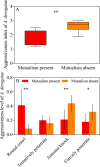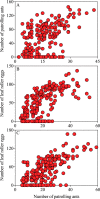Ant-mealybug mutualism modulates the performance of co-occurring herbivores
- PMID: 31506506
- PMCID: PMC6737150
- DOI: 10.1038/s41598-019-49334-3
Ant-mealybug mutualism modulates the performance of co-occurring herbivores
Abstract
Mutualism between ants and honeydew producing hemipterans has been extensively studied. However, little is known on how ant-hemipteran mutualism impacts the co-occurring herbivores, which in turn affect the mutual relationship in ecosystems. Herein, we investigated the effect of ant-mealybug mutualism on the oviposition preference and spatial distribution of cotton leaf roller Sylepta derogata, a polyphagous herbivore, and in Apantetes derogatae performance, a larvae parasitoid of S. derogata. Leaf rollers constructed shelters for mealybugs to prevent them from enemy attack and preferred to lay eggs on plants with ant-mealybug mutualism. Egg abundance on mutualism-present plants was higher than on mutualism-absent plants. Leaf roller parasitoid A. derogatae showed higher parasitism on mutualism-absent plants. No obvious change in leaf roller egg abundance was observed when A. derogatae was excluded, suggesting that the parasitic pressure can also regulate the oviposition behavior of S. derogate. Apantetes derogatae showed higher aggressiveness in parasitizing leaf roller larvae at the absence of the mutualism. There was a definite correlation between leaf roller egg abundance and the number of patrolling ants on plants. Without ant-mealybug mutualism, S. derogata eggs showed a significantly aggregated distribution pattern, but a uniform distribution pattern was observed when the mutualism was present. Ant workers showed a consistently uniform distribution on plants. The results reveal a novel mediation effect of ant-mealybug association on the composition and structure of food webs in cotton field, which may contribute to a better understanding of the cascading effects of ant-hemipteran mutualism on other niche-related species in ecosystem.
Conflict of interest statement
The authors declare no competing interests.
Figures








Similar articles
-
Fire ants protect mealybugs against their natural enemies by utilizing the leaf shelters constructed by the leaf roller Sylepta derogata.PLoS One. 2012;7(11):e49982. doi: 10.1371/journal.pone.0049982. Epub 2012 Nov 21. PLoS One. 2012. PMID: 23185505 Free PMC article.
-
Solenopsis invicta (Hymenoptera: Formicidae), defend Phenacoccus solenopsis (Hemiptera: Pseudococcidae) against its natural enemies.Environ Entomol. 2013 Apr;42(2):247-52. doi: 10.1603/EN12168. Environ Entomol. 2013. PMID: 23575014
-
Does mutualism drive the invasion of two alien species? The case of Solenopsis invicta and Phenacoccus solenopsis.PLoS One. 2012;7(7):e41856. doi: 10.1371/journal.pone.0041856. Epub 2012 Jul 23. PLoS One. 2012. PMID: 22911859 Free PMC article.
-
Ecological consequences of interactions between ants and honeydew-producing insects.Proc Biol Sci. 2007 Jan 22;274(1607):151-64. doi: 10.1098/rspb.2006.3701. Proc Biol Sci. 2007. PMID: 17148245 Free PMC article. Review.
-
Chemical communication in ant-hemipteran mutualism: potential implications for ant invasions.Curr Opin Insect Sci. 2021 Jun;45:121-129. doi: 10.1016/j.cois.2021.04.004. Epub 2021 Apr 24. Curr Opin Insect Sci. 2021. PMID: 33901733 Review.
Cited by
-
Surprising effects of cascading higher order interactions.Sci Rep. 2022 Nov 12;12(1):19378. doi: 10.1038/s41598-022-23763-z. Sci Rep. 2022. PMID: 36371593 Free PMC article.
-
Relationship between the honeydew of mealy bugs and the growth of Phlebopus portentosus.PLoS One. 2020 Jun 12;15(6):e0233710. doi: 10.1371/journal.pone.0233710. eCollection 2020. PLoS One. 2020. PMID: 32530963 Free PMC article.
-
Interference Competition for Mutualism between Ant Species Mediates Ant-Mealybug Associations.Insects. 2020 Feb 1;11(2):91. doi: 10.3390/insects11020091. Insects. 2020. PMID: 32024041 Free PMC article.
-
An update to the taxonomy and distribution of the Arabian Tapinoma Foerster, 1850 (Hymenoptera: Formicidae) with an illustrated key and remarks on habitats.Biodivers Data J. 2021 May 27;9:e66058. doi: 10.3897/BDJ.9.e66058. eCollection 2021. Biodivers Data J. 2021. PMID: 34093057 Free PMC article.
References
-
- Brightwell RJ, Silverman J. Invasive Argentine ants reduce fitness of red maple via a mutualism with an endemic coccid. Biol Invasions. 2010;12:2051–2057. doi: 10.1007/s10530-009-9607-0. - DOI
Publication types
MeSH terms
LinkOut - more resources
Full Text Sources

